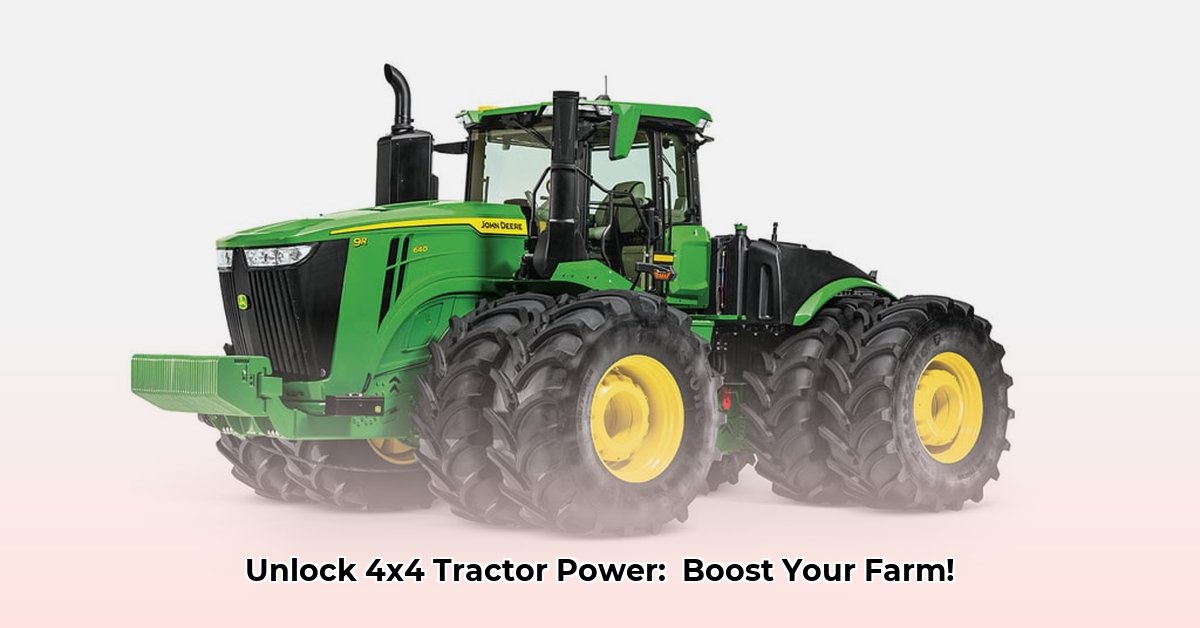
4x4 Tractor: Powering Your Farm's Future
Farming is demanding, but 4x4 tractors offer increased efficiency and ease of operation. Their superior traction and capabilities transform agricultural practices. This guide explores the benefits, buying process, and technological advancements shaping the 4x4 tractor market. Are you ready to streamline your farm operations? For more on precision farming, check out these GPS guidance systems.
Why Choose a 4x4 Tractor?
A 4x4 tractor provides superior traction, minimizing downtime and maximizing productivity. All-wheel drive ensures consistent performance across varied terrains, from muddy fields to hilly landscapes. This translates to faster task completion, reduced fuel consumption, and a smoother, more comfortable operating experience. This is not just about raw power; it's about efficient, smart work.
Navigating the 4x4 Tractor Marketplace: Finding Your Perfect Match
The 4x4 tractor market offers diverse options based on farm size and operational needs. How can you find the ideal match?
- Small Farms and Hobby Farms: Compact, lower-horsepower models offer maneuverability in smaller spaces.
- Large-Scale Operations: High-horsepower tractors with features like GPS-guided steering, automatic transmissions, and powerful PTOs (Power Take-Off – the measure of power delivered to implements) are crucial for efficiency at scale.
- Specialized Needs: Vineyards and orchards require smaller, specialized models designed for narrow rows and delicate operations.
Did you know that GPS-guided steering can reduce overlap by up to 15%, saving valuable resources?
Technological Marvels: 4x4 Tractors Get Smart
Modern 4x4 tractors incorporate advanced technologies to enhance performance and efficiency.
- GPS-Guided Steering: Automated steering increases accuracy, minimizes resource waste (seeds, fertilizer), and reduces operator fatigue.
- Telematics: Remote monitoring capabilities track fuel consumption, diagnose potential problems, and allow for proactive maintenance scheduling. "Modern telematics systems allow for real-time data analysis, which is invaluable for optimizing farm management," says Dr. Anya Sharma, Agricultural Engineering Professor at Purdue University.
- Automatic Transmissions: Automatic transmissions optimize gear shifting, improving operator comfort and reducing fatigue.
- User-Friendly Interfaces: Intuitive touchscreens and customizable settings simplify operation.
- PTO Power: The PTO horsepower is the key indicator of a tractor's true work capacity, determining the power delivered to attached implements. Don't overlook this crucial specification! Forty percent of tractor downtime is attributed to PTO related issues, according to the National Farm Machinery Association.
Investing Wisely: Your Step-by-Step Guide to Buying a 4x4 Tractor
Buying a 4x4 tractor requires careful consideration and planning. Follow these steps for a successful purchase:
- Assess Your Needs: Determine the tractor's intended tasks, farm size, and soil conditions.
- Set a Realistic Budget: Account for purchase price, maintenance costs, and financing options. Remember to factor in potential repairs and long-term upkeep.
- Research Thoroughly: Compare models, manufacturers, horsepower, features, warranties, and customer reviews.
- Test Drive: A test drive is crucial to assess comfort, maneuverability, and ease of use.
- Seek Expert Advice: Consult experienced farmers or agricultural professionals to guide your decision.
Weighing the Pros and Cons: Is a 4x4 Tractor Right for You?
| Feature | Pros | Cons |
|---|---|---|
| Traction | Superior grip; increased productivity. | Slightly lower fuel efficiency in optimal conditions. |
| Power | Handles challenging tasks; improved pulling power. | Higher initial cost than 2WD tractors. |
| Technology | Advanced features; improved efficiency. | Increased complexity, potential for technical issues. |
| Maintenance | More complex maintenance. | Potentially higher maintenance costs. |
How to Compare PTO Horsepower vs. Engine Horsepower in Agricultural Tractors
Understanding the difference between PTO (power take-off) and engine horsepower is vital for correctly matching tractors to tasks. PTO horsepower is always less than engine horsepower due to power losses in the drivetrain. This difference is critical for avoiding underpowering and wasted expenditure.
Understanding the Powertrain's Impact
The engine generates raw power, while the PTO delivers it to implements. Power loss occurs throughout the transmission, hydraulics, and other components.
Factors Influencing Power Loss
Several factors influence power loss: transmission type, tractor age, PTO speed, and accessory loads. "Ignoring these power loss factors can lead to significant mismatches and reduced productivity," observes John Miller, Chief Engineer at Case IH.
Decoding Horsepower Ratings
Horsepower ratings can vary (gross vs. net). Always ensure that you're comparing like-for-like figures. Consult standardized test data for reliable comparisons.
Making Informed Comparisons
- Prioritize PTO HP: PTO horsepower is the more relevant figure for matching tractors to implements.
- Check the Fine Print: Pay close attention to how horsepower ratings are defined.
- Use Standardized Tests: Consult resources like Nebraska Tractor Tests (https://tractordata.com/) for standardized testing and objective performance data.
- Consider Overall Efficiency: Evaluate fuel efficiency and operating costs alongside horsepower.
Remember that total efficiency, considering fuel consumption and operational cost, is equally as important as pure horsepower figures. Choosing the right 4x4 tractor is a significant investment, but with careful planning and consideration, you can transform your farm's efficiency and productivity.